Alfa Romeo 147 2010 Owner handbook (in English)
Manufacturer: ALFA ROMEO, Model Year: 2010, Model line: 147, Model: Alfa Romeo 147 2010Pages: 291, PDF Size: 5.52 MB
Page 91 of 291
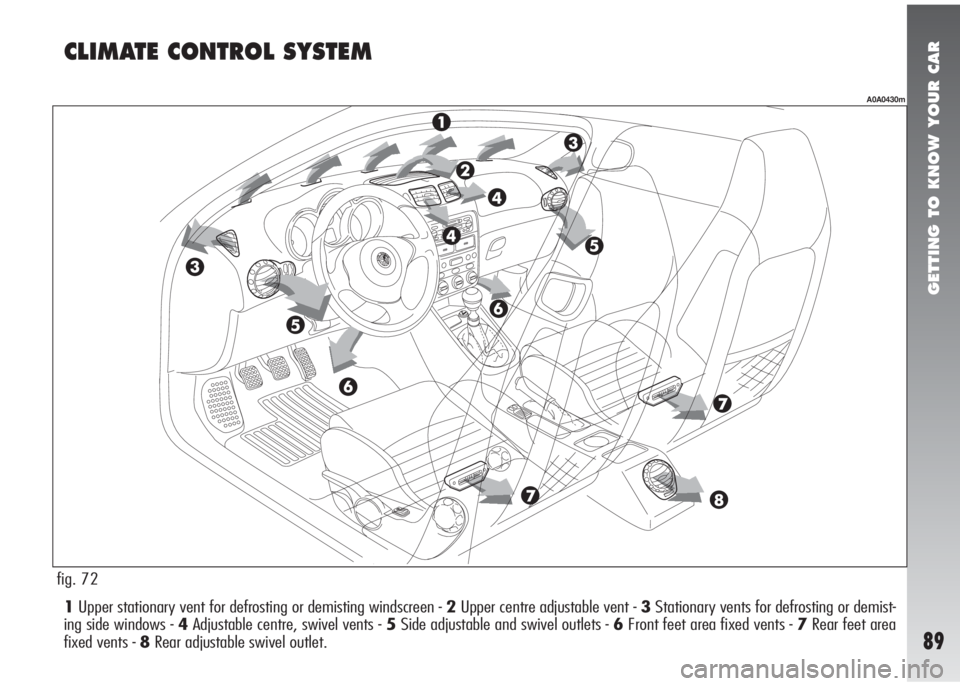
GETTING TO KNOW YOUR CAR
89
1Upper stationary vent for defrosting or demisting windscreen - 2Upper centre adjustable vent - 3Stationary vents for defrosting or demist-
ing side windows - 4Adjustable centre, swivel vents - 5Side adjustable and swivel outlets - 6Front feet area fixed vents - 7Rear feet area
fixed vents - 8Rear adjustable swivel outlet.
CLIMATE CONTROL SYSTEM
fig. 72
A0A0430m
Page 92 of 291
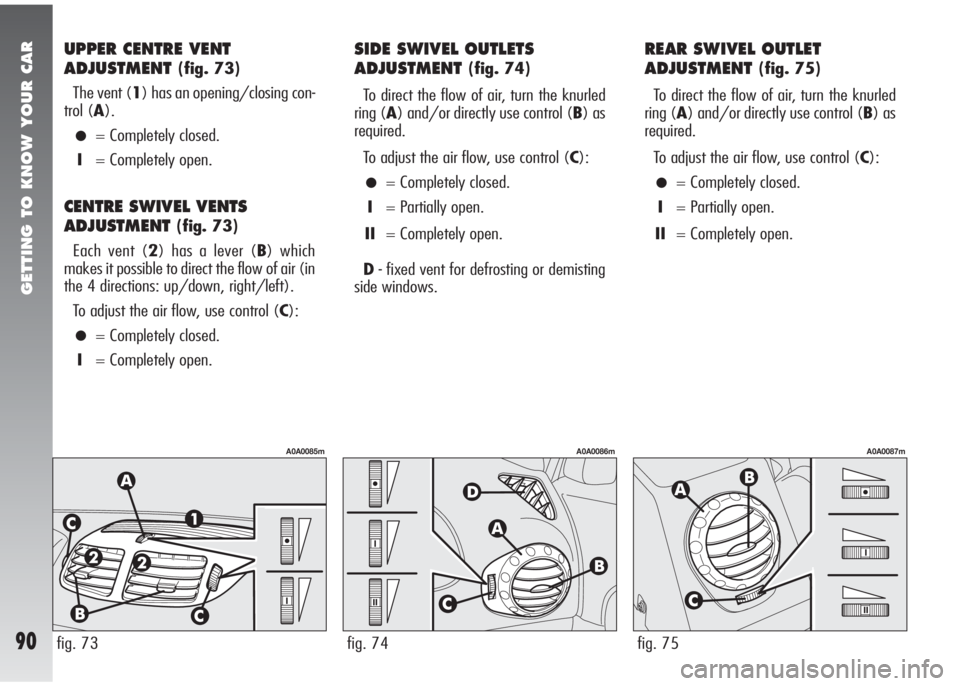
GETTING TO KNOW YOUR CAR
90fig. 73fig. 74fig. 75
UPPER CENTRE VENT
ADJUSTMENT
(fig. 73)
The vent (1) has an opening/closing con-
trol (A).
•= Completely closed.
I= Completely open.
CENTRE SWIVEL VENTS
ADJUSTMENT
(fig. 73)
Each vent (2) has a lever (B) which
makes it possible to direct the flow of air (in
the 4 directions: up/down, right/left).
To adjust the air flow, use control (C):
•= Completely closed.
I= Completely open.
SIDE SWIVEL OUTLETS
ADJUSTMENT
(fig. 74)
To direct the flow of air, turn the knurled
ring (A) and/or directly use control (B) as
required.
To adjust the air flow, use control (C):
•= Completely closed.
I= Partially open.
II= Completely open.
D- fixed vent for defrosting or demisting
side windows.
REAR SWIVEL OUTLET
ADJUSTMENT
(fig. 75)
To direct the flow of air, turn the knurled
ring (A) and/or directly use control (B) as
required.
To adjust the air flow, use control (C):
•= Completely closed.
I= Partially open.
II= Completely open.
A0A0085mA0A0086mA0A0087m
Page 93 of 291
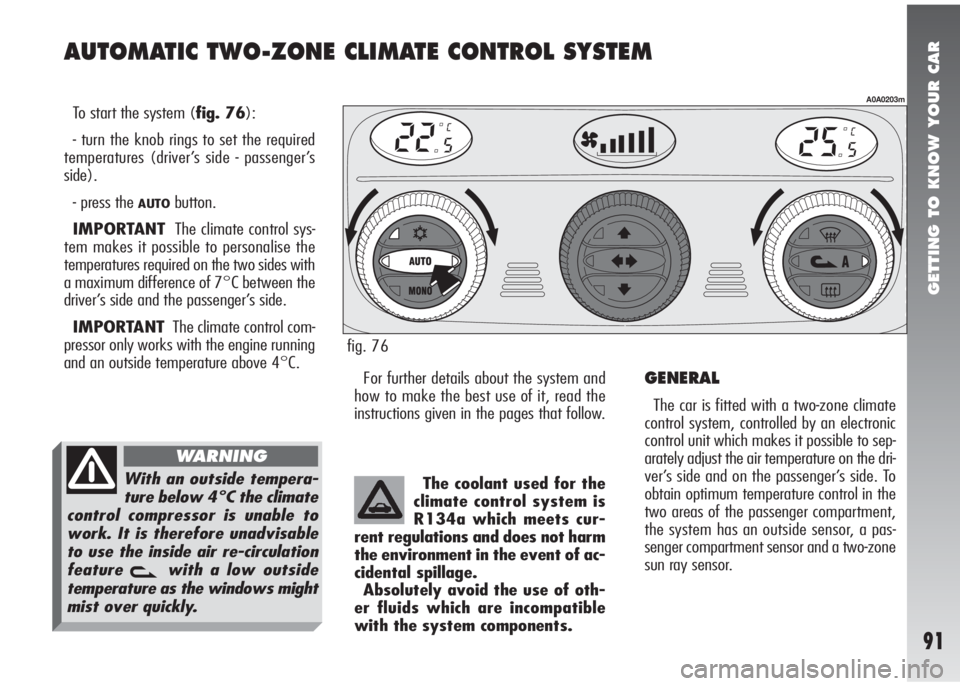
GETTING TO KNOW YOUR CAR
91
AUTOMATIC TWO-ZONE CLIMATE CONTROL SYSTEM
To start the system (fig. 76):
- turn the knob rings to set the required
temperatures (driver’s side - passenger’s
side).
- press the
AUTObutton.
IMPORTANTThe climate control sys-
tem makes it possible to personalise the
temperatures required on the two sides with
a maximum difference of 7°C between the
driver’s side and the passenger’s side.
IMPORTANTThe climate control com-
pressor only works with the engine running
and an outside temperature above 4°C.
For further details about the system and
how to make the best use of it, read the
instructions given in the pages that follow.
A0A0203m
fig. 76
The coolant used for the
climate control system is
R134a which meets cur-
rent regulations and does not harm
the environment in the event of ac-
cidental spillage.
Absolutely avoid the use of oth-
er fluids which are incompatible
with the system components.
GENERAL
The car is fitted with a two-zone climate
control system, controlled by an electronic
control unit which makes it possible to sep-
arately adjust the air temperature on the dri-
ver’s side and on the passenger’s side. To
obtain optimum temperature control in the
two areas of the passenger compartment,
the system has an outside sensor, a pas-
senger compartment sensor and a two-zone
sun ray sensor.
With an outside tempera-
ture below 4°C the climate
control compressor is unable to
work. It is therefore unadvisable
to use the inside air re-circulation
feature
vwith a low outside
temperature as the windows might
mist over quickly.
WARNING
Page 94 of 291
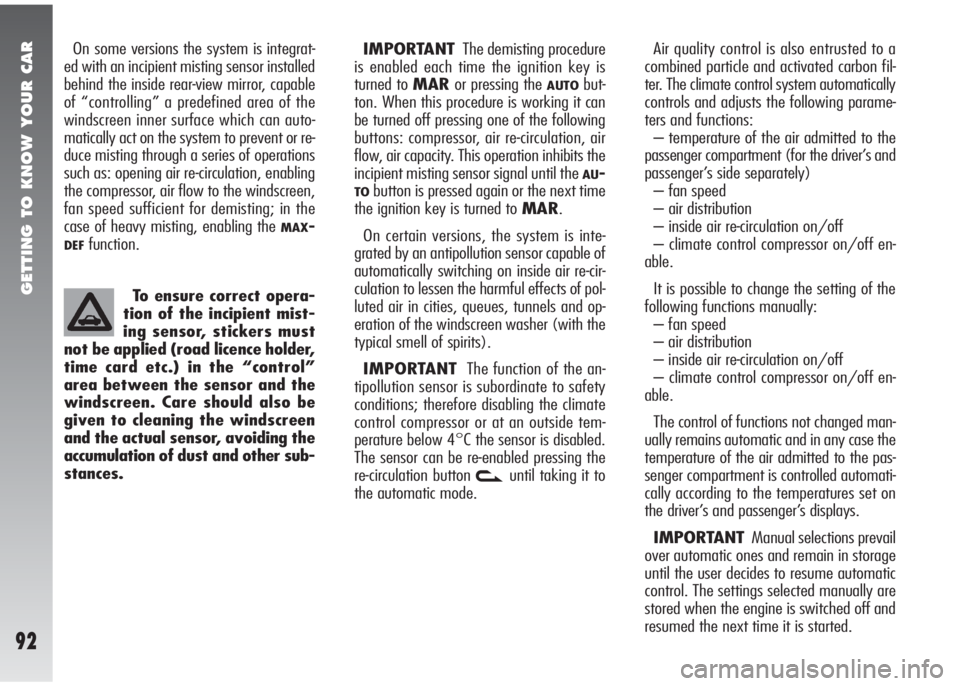
GETTING TO KNOW YOUR CAR
92
Air quality control is also entrusted to a
combined particle and activated carbon fil-
ter. The climate control system automatically
controls and adjusts the following parame-
ters and functions:
– temperature of the air admitted to the
passenger compartment (for the driver’s and
passenger’s side separately)
– fan speed
– air distribution
– inside air re-circulation on/off
– climate control compressor on/off en-
able.
It is possible to change the setting of the
following functions manually:
– fan speed
– air distribution
– inside air re-circulation on/off
– climate control compressor on/off en-
able.
The control of functions not changed man-
ually remains automatic and in any case the
temperature of the air admitted to the pas-
senger compartment is controlled automati-
cally according to the temperatures set on
the driver’s and passenger’s displays.
IMPORTANTManual selections prevail
over automatic ones and remain in storage
until the user decides to resume automatic
control. The settings selected manually are
stored when the engine is switched off and
resumed the next time it is started. To ensure correct opera-
tion of the incipient mist-
ing sensor, stickers must
not be applied (road licence holder,
time card etc.) in the “control”
area between the sensor and the
windscreen. Care should also be
given to cleaning the windscreen
and the actual sensor, avoiding the
accumulation of dust and other sub-
stances.IMPORTANTThe demisting procedure
is enabled each time the ignition key is
turned to MARor pressing the
AUTObut-
ton. When this procedure is working it can
be turned off pressing one of the following
buttons: compressor, air re-circulation, air
flow, air capacity. This operation inhibits the
incipient misting sensor signal until the
AU-
TObutton is pressed again or the next time
the ignition key is turned to MAR.
On certain versions, the system is inte-
grated by an antipollution sensor capable of
automatically switching on inside air re-cir-
culation to lessen the harmful effects of pol-
luted air in cities, queues, tunnels and op-
eration of the windscreen washer (with the
typical smell of spirits).
IMPORTANTThe function of the an-
tipollution sensor is subordinate to safety
conditions; therefore disabling the climate
control compressor or at an outside tem-
perature below 4°C the sensor is disabled.
The sensor can be re-enabled pressing the
re-circulation button
vuntil taking it to
the automatic mode. On some versions the system is integrat-
ed with an incipient misting sensor installed
behind the inside rear-view mirror, capable
of “controlling” a predefined area of the
windscreen inner surface which can auto-
matically act on the system to prevent or re-
duce misting through a series of operations
such as: opening air re-circulation, enabling
the compressor, air flow to the windscreen,
fan speed sufficient for demisting; in the
case of heavy misting, enabling the
MAX-
DEFfunction.
Page 95 of 291
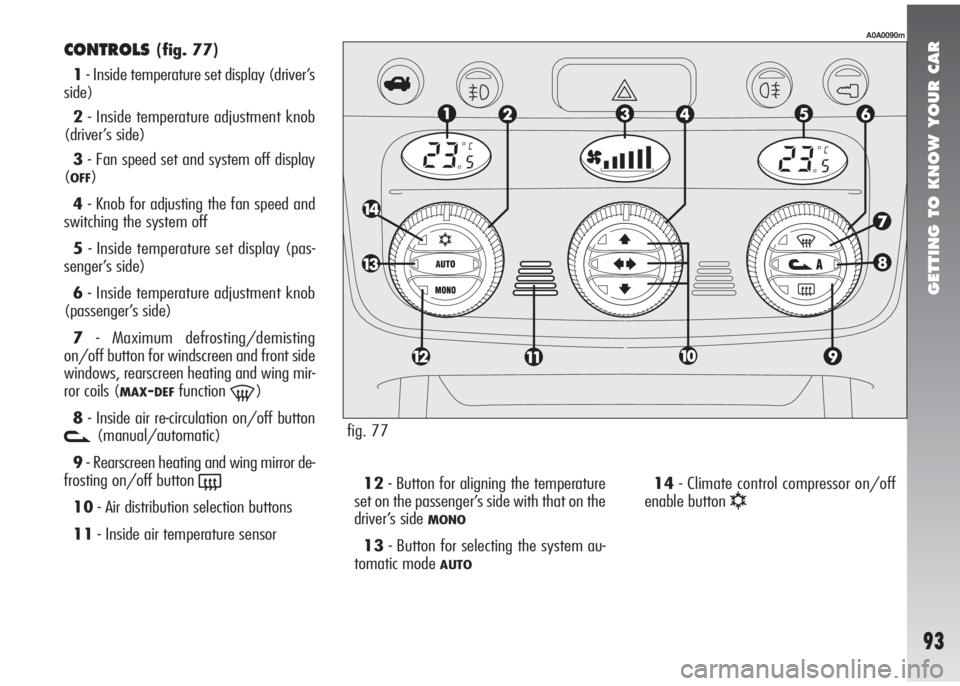
GETTING TO KNOW YOUR CAR
93
CONTROLS(fig. 77)
1- Inside temperature set display (driver’s
side)
2- Inside temperature adjustment knob
(driver’s side)
3- Fan speed set and system off display
(
OFF)
4- Knob for adjusting the fan speed and
switching the system off
5- Inside temperature set display (pas-
senger’s side)
6- Inside temperature adjustment knob
(passenger’s side)
7- Maximum defrosting/demisting
on/off button for windscreen and front side
windows, rearscreen heating and wing mir-
ror coils (
MAX-DEFfunction-)
8- Inside air re-circulation on/off button
v(manual/automatic)
9- Rearscreen heating and wing mirror de-
frosting on/off button
(
10- Air distribution selection buttons
11- Inside air temperature sensor12- Button for aligning the temperature
set on the passenger’s side with that on the
driver’s side MONO
13- Button for selecting the system au-
tomatic mode
AUTO
14- Climate control compressor on/off
enable button
√
fig. 77
A0A0090m
Page 96 of 291
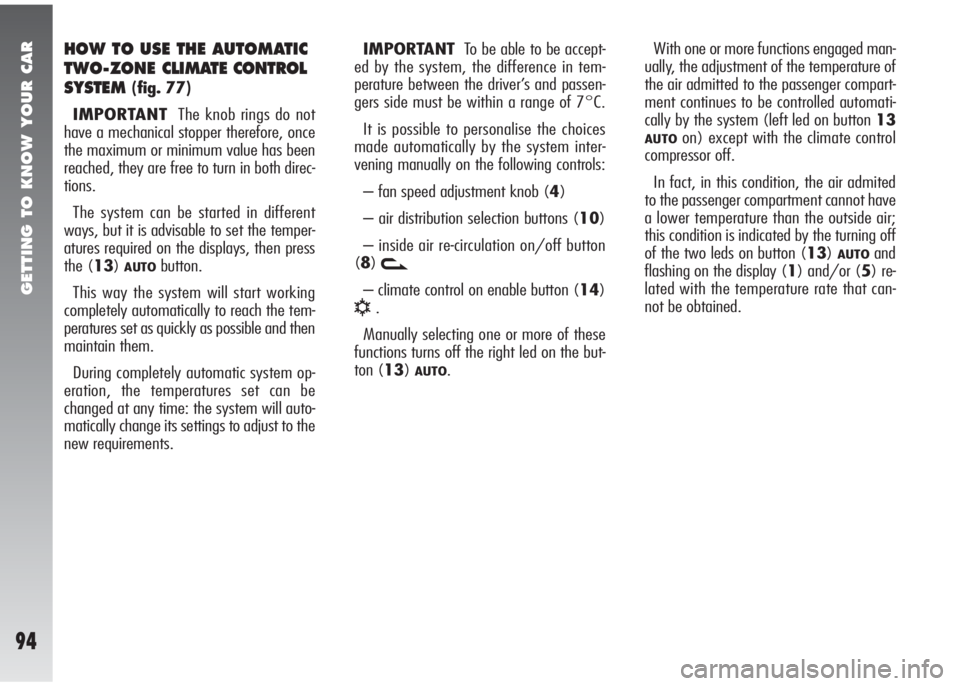
GETTING TO KNOW YOUR CAR
94
HOW TO USE THE AUTOMATIC
TWO-ZONECLIMATE CONTROL
SYSTEM
(fig. 77)
IMPORTANTThe knob rings do not
have a mechanical stopper therefore, once
the maximum or minimum value has been
reached, they are free to turn in both direc-
tions.
The system can be started in different
ways, but it is advisable to set the temper-
atures required on the displays, then press
the (13)
AUTObutton.
This way the system will start working
completely automatically to reach the tem-
peratures set as quickly as possible and then
maintain them.
During completely automatic system op-
eration, the temperatures set can be
changed at any time: the system will auto-
matically change its settings to adjust to the
new requirements.IMPORTANTTo be able to be accept-
ed by the system, the difference in tem-
perature between the driver’s and passen-
gers side must be within a range of 7°C.
It is possible to personalise the choices
made automatically by the system inter-
vening manually on the following controls:
– fan speed adjustment knob (4)
– air distribution selection buttons (10)
– inside air re-circulation on/off button
(8)v
– climate control on enable button (14)
√.
Manually selecting one or more of these
functions turns off the right led on the but-
ton (13)
AUTO.With one or more functions engaged man-
ually, the adjustment of the temperature of
the air admitted to the passenger compart-
ment continues to be controlled automati-
cally by the system (left led on button 13
AUTOon) except with the climate control
compressor off.
In fact, in this condition, the air admited
to the passenger compartment cannot have
a lower temperature than the outside air;
this condition is indicated by the turning off
of the two leds on button (13)
AUTOand
flashing on the display (1) and/or (5) re-
lated with the temperature rate that can-
not be obtained.
Page 97 of 291
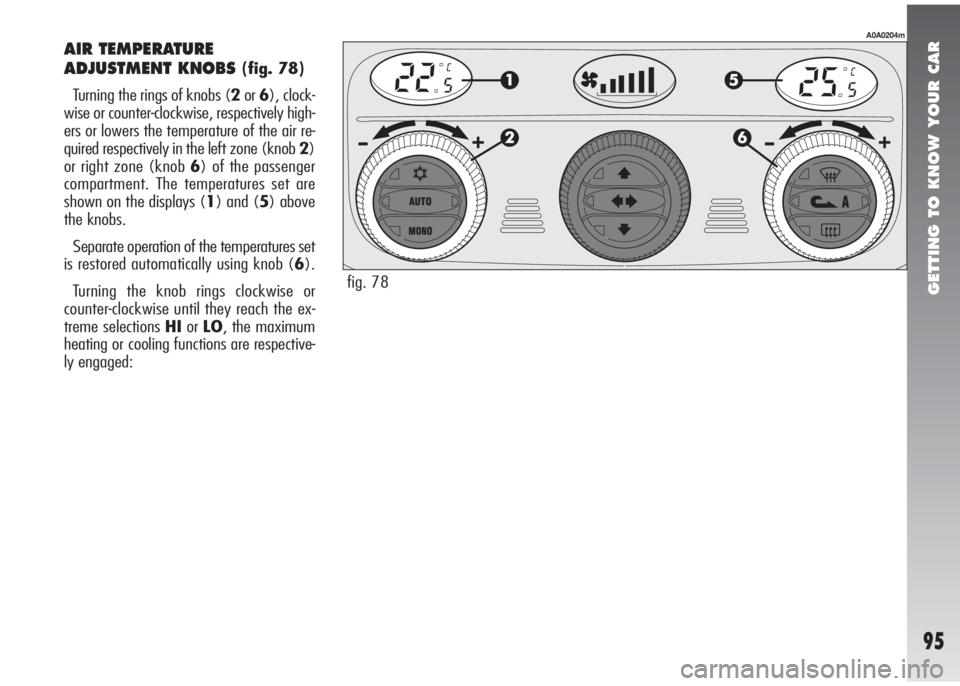
GETTING TO KNOW YOUR CAR
95
AIR TEMPERATURE
ADJUSTMENT KNOBS
(fig. 78)
Turning the rings of knobs (2or6), clock-
wise or counter-clockwise, respectively high-
ers or lowers the temperature of the air re-
quired respectively in the left zone (knob 2)
or right zone (knob 6) of the passenger
compartment. The temperatures set are
shown on the displays (1) and (5) above
the knobs.
Separate operation of the temperatures set
is restored automatically using knob (6).
Turning the knob rings clockwise or
counter-clockwise until they reach the ex-
treme selections HIorLO, the maximum
heating or cooling functions are respective-
ly engaged:
A0A0204m
fig. 78
Page 98 of 291
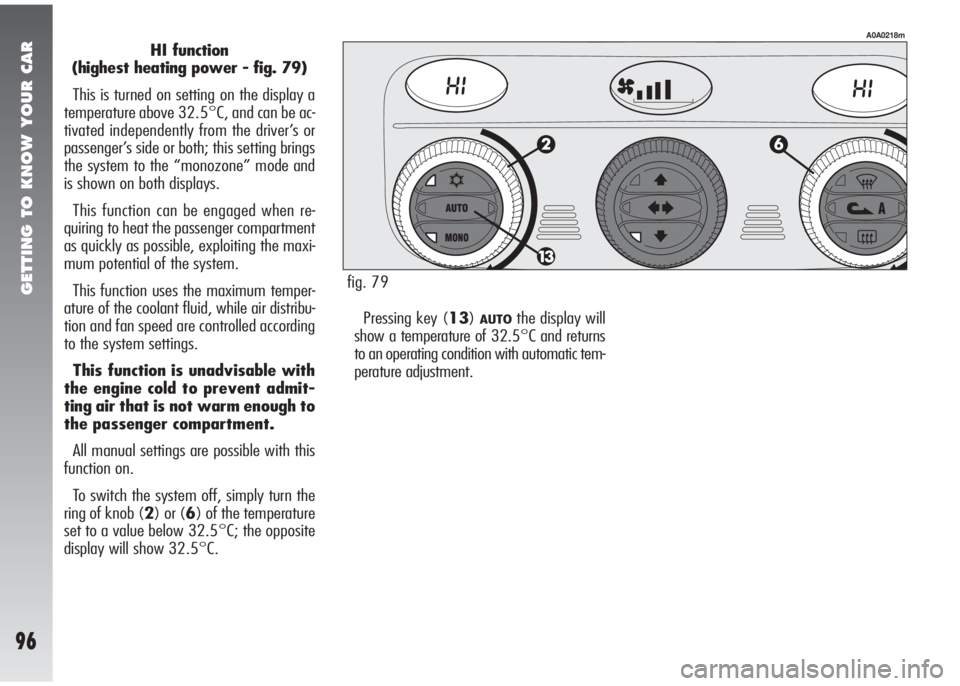
GETTING TO KNOW YOUR CAR
96
HI function
(highest heating power - fig. 79)
This is turned on setting on the display a
temperature above 32.5°C, and can be ac-
tivated independently from the driver’s or
passenger’s side or both; this setting brings
the system to the “monozone” mode and
is shown on both displays.
This function can be engaged when re-
quiring to heat the passenger compartment
as quickly as possible, exploiting the maxi-
mum potential of the system.
This function uses the maximum temper-
ature of the coolant fluid, while air distribu-
tion and fan speed are controlled according
to the system settings.
This function is unadvisable with
the engine cold to prevent admit-
ting air that is not warm enough to
the passenger compartment.
All manual settings are possible with this
function on.
To switch the system off, simply turn the
ring of knob (2) or (6) of the temperature
set to a value below 32.5°C; the opposite
display will show 32.5°C.
A0A0218m
fig. 79
Pressing key (13)
AUTOthe display will
show a temperature of 32.5°C and returns
to an operating condition with automatic tem-
perature adjustment.
Page 99 of 291
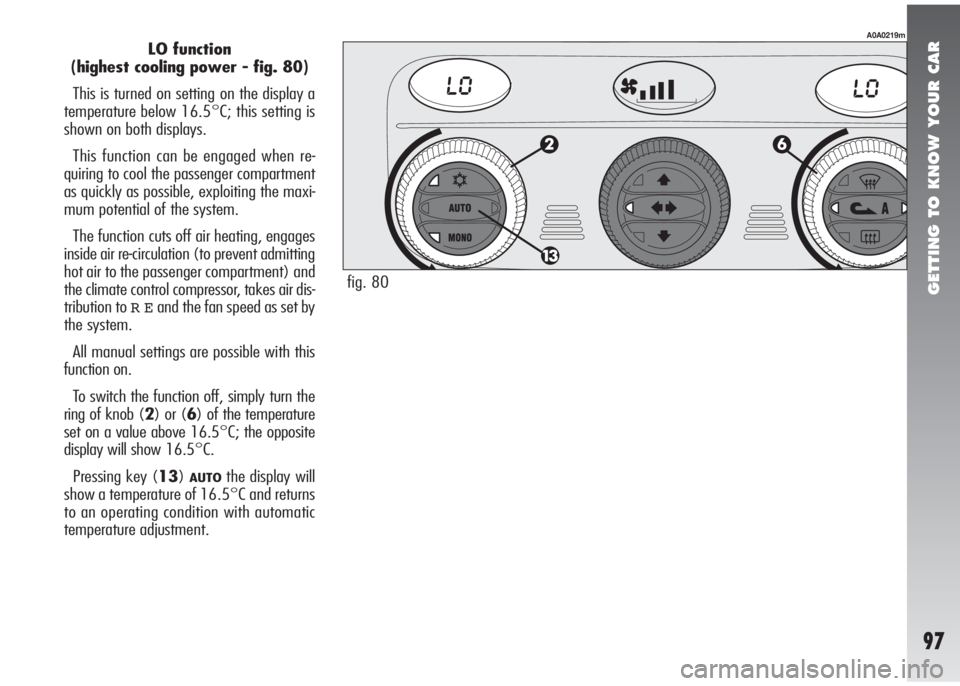
GETTING TO KNOW YOUR CAR
97
LO function
(highest cooling power - fig. 80)
This is turned on setting on the display a
temperature below 16.5°C; this setting is
shown on both displays.
This function can be engaged when re-
quiring to cool the passenger compartment
as quickly as possible, exploiting the maxi-
mum potential of the system.
The function cuts off air heating, engages
inside air re-circulation (to prevent admitting
hot air to the passenger compartment) and
the climate control compressor, takes air dis-
tribution to
REand the fan speed as set by
the system.
All manual settings are possible with this
function on.
To switch the function off, simply turn the
ring of knob (2) or (6) of the temperature
set on a value above 16.5°C; the opposite
display will show 16.5°C.
Pressing key (13)
AUTOthe display will
show a temperature of 16.5°C and returns
to an operating condition with automatic
temperature adjustment.
A0A0219m
fig. 80
Page 100 of 291

GETTING TO KNOW YOUR CAR
98
MONO BUTTON FOR
ALIGNMENT OF THE
TEMPERATURES SET
(fig. 81)
Pressing button (12)
MONOautomatically
aligns the the temperature on the passen-
ger’s side with that on the driver’s side,
therefore it is possible to set the same tem-
perature between the two zones simply turn-
ing the ring of knob (2) on the driver’s side.
This function is provided to simplify tem-
perature adjustment of the whole passen-
ger compartment when only the driver is on
board.
Separate operation of the temperatures set
is automatically restored when the passen-
ger uses the ring on knob (6) or presses
button (12)
MONO.
A0A0207m
fig. 81